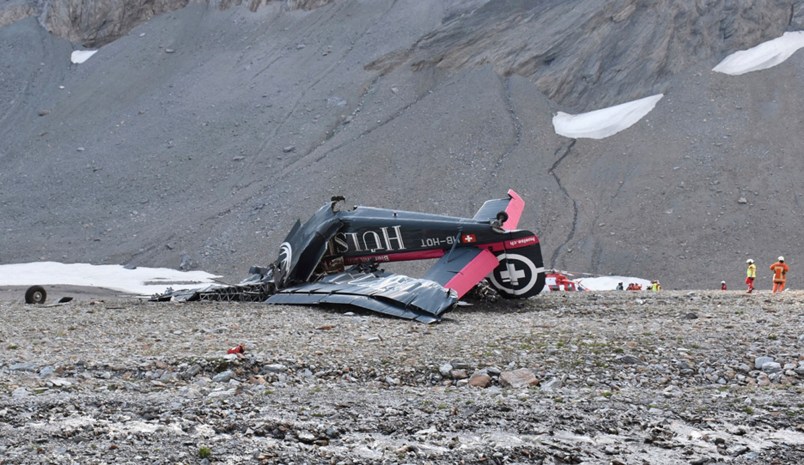BERLIN (AP) — A vintage propeller plane plunged near-vertically into a Swiss mountain, killing all 20 people on board as they returned from a two-day trip to southern Switzerland, investigators said Sunday.
The Junkers Ju-52 plane, operated by small Swiss company Ju-Air, went down Saturday on the Piz Segnas mountain above the Alpine resort of Flims in the country’s southeast, at an altitude of about 2,540 meters (8,330 feet) above sea level.
There was no immediate word on the cause of the crash, and officials said they expect a complex investigation given that the 79-year-old plane was not equipped with black boxes.
Police said Sunday they had determined that the 17 passengers and three crew members on board the plane all died.
The victims were 11 men and nine women between the ages of 42 and 84— seven couples from various parts of Switzerland, a couple from neighboring Austria and their son, and the three crew members. Their names were not released.
The fully booked plane was flying the passengers back to its base at Duebendorf, near Zurich, from a two-day trip to Switzerland’s Italian-speaking southern Ticino region. It crashed shortly before 5 p.m. Saturday, less than 50 minutes after taking off from Locarno’s Magadino airfield.
Photos released by Graubuenden canton (state) police showed the crumpled wreckage of the plane lying on the mountain, with only the upside-down tail more or less intact.
Police said they were not aware of any distress call from the aircraft before it crashed.
“We can assume that the aircraft hit the ground near-vertically and at relatively high speed,” Daniel Knecht of the Swiss Transportation Safety Investigation Board said at a news conference in Flims.
He and senior police official Andreas Tobler said the vintage plane lacked “black boxes,” the crash-resistant cockpit voice and data recorders that more modern aircraft have.
Knecht said officials expect the investigation of the cause to be “relatively complex, because we have to compare various indications, information and evidence and evaluate them.”
There also are typically few radar recordings in mountainous areas such as the one where the crash site is located, he added.
Officials can essentially rule out a collision with another aircraft or an obstacle such as a wire, Knecht said. There also was no indication of any “external influence,” he said, indicating that authorities don’t suspect foul play.
The plane did not catch on fire before or after it hit the mountain, and investigators have not found any signs the aircraft lost parts or broke up in the air before the crash, Knecht said.
The area around the crash site, which is popular with hikers and skiers and includes a glacier, was closed to the public. Knecht said authorities would probably need “a few days” to complete recovery work.
Officials appeared dubious about suggestions that unusually hot weather in Switzerland, like other parts of Europe, might have been a main cause of the crash. Knecht said that while heat can affect an aircraft’s performance, experienced pilots could deal with that.
Knecht also dismissed the idea that the plane’s age was necessarily a problem.
“Older planes, if they are correctly maintained, can be operated safely,” he said.
Nearly 5,000 Ju-52 planes, a product of Germany’s Junkers, were manufactured between 1932 and 1952.
Ju-Air’s Ju-52 planes are former Swiss military aircraft, built in 1939, that were retired by the air force in 1981.
Ju-Air started operating flights with the old-timers in 1983, and the plane that crashed — with the registration HB-HOT — had been in service with the company since 1985.
Chief executive and co-founder Kurt Waldmeier said the planes “are flown exclusively by very experienced professional pilots, and strictly checked and maintained by our own technicians.”
The plane that crashed had logged 10,187 hours of flying time, he said, adding that it underwent maintenance after every 35 hours of flight — most recently at the end of July. He said it had its full annual service during the winter, and “we know of no technical problems with this aircraft.”
The two pilots, who were 62 and 63-years-old, both had extensive experience with the Ju-52 and had long worked as airline and Swiss air force pilots, Waldmeier said.
The aircraft have three engines, one on the nose and one on each wing. Waldmeier said the pilots fly by sight along pre-planned routes.
“We cannot yet explain what led to the tragic accident on Piz Segnas,” he said.
Ju-Air offers “adventure flights” for people wanting to experience Switzerland’s landscape from vintage planes.
A brochure on the company’s website listed the cost of the 2-day Locarno trip as 1,130 francs ($1,136), including meals and a night in a hotel.
The company, which operates two other Ju-52s, suspended flights until further notice after the crash.







Here’s a “before” picture of the aircraft.
There aren’t a lot of things that make an aircraft that size fall nose-first out of the sky. First question is how fast it was going, because 100 mph is typical of normal flight.
Doubt it. Looks like it at least tried to land. Way too much of it left for a nose-in.
We’ll find out in some months if there’s a report issued. Can’t have been that much forward speed either or the wreckage would be more scattered.
Sad and odd.
Looks like the plane in “Where Eagles Dare.” They were the German equivalent of the Douglas C-47. Old airframe. Wouldn’t be surprised if a control rusted out. The pilots were trying to fly the plane all the way to the ground. I have to agree that aircraft came in pretty shallow or it would have been in a lot more pieces.